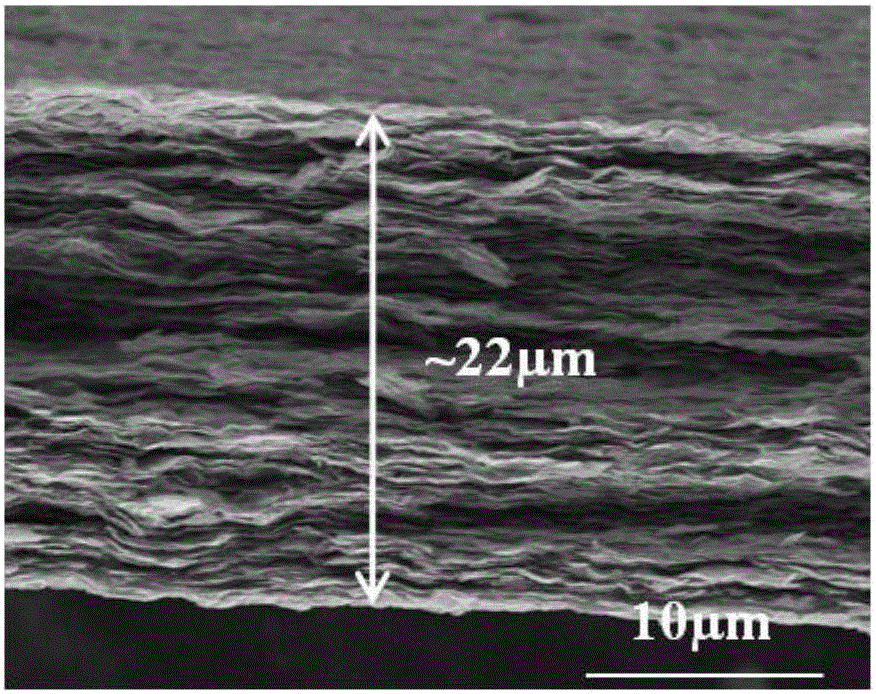High-thermal-conductivity flexible graphene composite material and preparation method therefor, and lithium ion battery
A lithium ion battery and composite material technology, which is applied in the field of lithium ion battery, high thermal conductivity flexible lithium ion battery negative electrode graphene composite material and its preparation field, can solve the problems of reducing electrode area, breaking or falling off, decreasing cycle life and the like, Achieve the effect of buffering volume expansion, high thermal conductivity, and increasing electrical conductivity
- Summary
- Abstract
- Description
- Claims
- Application Information
AI Technical Summary
Problems solved by technology
Method used
Image
Examples
preparation example Construction
[0028] see figure 1 , a method for preparing a highly thermally conductive flexible lithium-ion battery negative electrode graphene composite material, comprising the steps of:
[0029] S110, soaking the graphite rod in the inorganic salt solution to fully infiltrate the graphite rod.
[0030] Specifically, use sandpaper to polish and decontaminate the surface of the graphite rod before use. The inorganic salt solution is selected from sodium stannate (Na 2 SnO 3 ) solution and potassium stannate (K 2 SnO 3 ) in one of the solutions. The concentration of the inorganic salt solution may be 0.1mol / L˜1mol / L. The anion stannate ion contained in sodium stannate and potassium stannate (SnO 3 2- ) is equivalent to the distance (0.34nm) between the graphite flakes, which can intercalate between the graphite flakes to reduce the Van der Waals force between the graphite flakes, which is beneficial to stripping and obtaining thin-layer graphene.
[0031] S120, using the graphite...
Embodiment 1
[0042] Use sandpaper to polish and decontaminate the surface of the graphite rod before use. Prepare 100 mL of Na with a concentration of 0.1 mol / L 2 SnO 3 solution, soak the graphite rod in Na 2 SnO 3 After the graphite rod is fully infiltrated by the solution for 1 h, the fully infiltrated graphite rod is used as the anode, the platinum sheet electrode is used as the cathode, and the Na 2 SnO 3 The solution is an electrolyte, which is assembled into an electrolytic cell system. A working voltage of 10V was applied between the cathode and the anode, and the electrochemical stripping was continued for 120min, and then the power was turned off to stop the stripping. After taking out the cathode and anode, the electrolyte was ultrasonically treated for 1 hour, and then centrifuged at 3000rmp / min for 20 minutes, and the remaining upper liquid was the graphene aqueous solution. The aqueous solution of graphene is vacuum filtered sequentially to obtain graphene / SnO 2 Composi...
Embodiment 2
[0049] Use sandpaper to polish and decontaminate the surface of the graphite rod before use. Prepare 100 mL of K with a concentration of 0.1 mol / L 2 SnO 3 solution, soak the graphite rod in K 2 SnO 3 After the graphite rod is fully infiltrated by the solution for 1 h, the fully infiltrated graphite rod is used as the anode, the platinum sheet electrode is used as the cathode, and the K 2 SnO 3 The solution is an electrolyte, which is assembled into an electrolytic cell system. A working voltage of 10V was applied between the cathode and the anode, and the electrochemical stripping was continued for 240min, and then the power was turned off to stop the stripping. After the cathode and anode were taken out, the electrolyte was ultrasonically treated for 1 hour, and then centrifuged at 1000rmp / min for 40 minutes, and the remaining upper liquid was the graphene aqueous solution. The aqueous solution of graphene is sequentially suction-filtered to obtain graphene / SnO 2 Compo...
PUM
| Property | Measurement | Unit |
|---|---|---|
| thickness | aaaaa | aaaaa |
Abstract
Description
Claims
Application Information
 Login to View More
Login to View More - R&D
- Intellectual Property
- Life Sciences
- Materials
- Tech Scout
- Unparalleled Data Quality
- Higher Quality Content
- 60% Fewer Hallucinations
Browse by: Latest US Patents, China's latest patents, Technical Efficacy Thesaurus, Application Domain, Technology Topic, Popular Technical Reports.
© 2025 PatSnap. All rights reserved.Legal|Privacy policy|Modern Slavery Act Transparency Statement|Sitemap|About US| Contact US: help@patsnap.com



